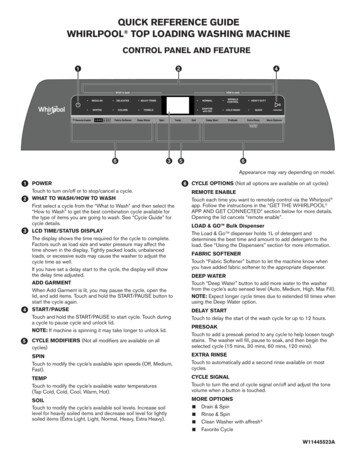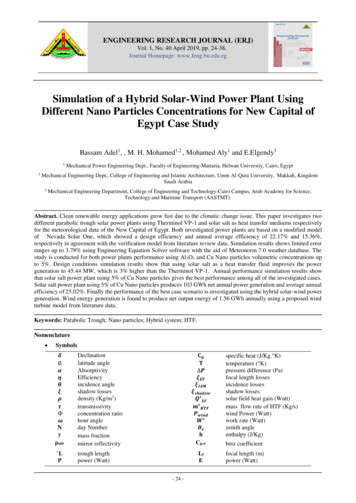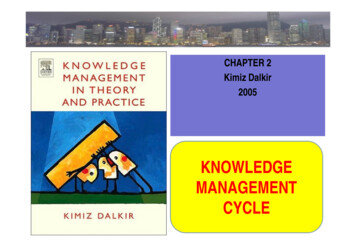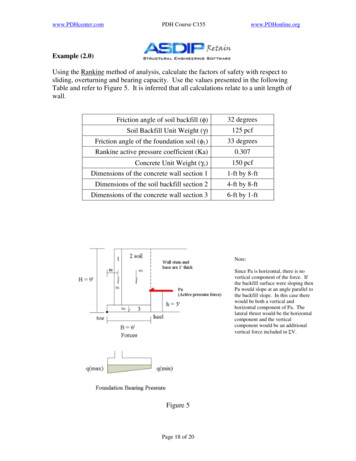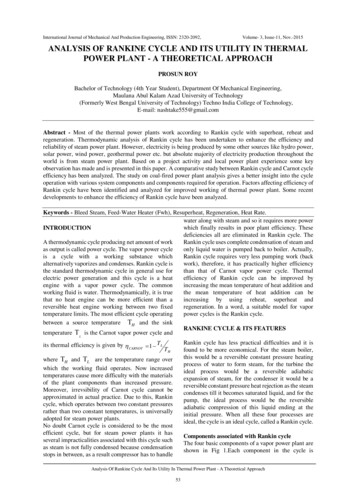
Transcription
International Journal of Mechanical And Production Engineering, ISSN: 2320-2092,Volume- 3, Issue-11, Nov.-2015ANALYSIS OF RANKINE CYCLE AND ITS UTILITY IN THERMALPOWER PLANT - A THEORETICAL APPROACHPROSUN ROYBachelor of Technology (4th Year Student), Department Of Mechanical Engineering,Maulana Abul Kalam Azad University of Technology(Formerly West Bengal University of Technology) Techno India College of Technology,E-mail: nashtake555@gmail.comAbstract - Most of the thermal power plants work according to Rankin cycle with superheat, reheat andregeneration. Thermodynamic analysis of Rankin cycle has been undertaken to enhance the efficiency andreliability of steam power plant. However, electricity is being produced by some other sources like hydro power,solar power, wind power, geothermal power etc. but absolute majority of electricity production throughout theworld is from steam power plant. Based on a project activity and local power plant experience some keyobservation has made and is presented in this paper. A comparative study between Rankin cycle and Carnot cycleefficiency has been analyzed. The study on coal-fired power plant analysis gives a better insight into the cycleoperation with various system components and components required for operation. Factors affecting efficiency ofRankin cycle have been identified and analyzed for improved working of thermal power plant. Some recentdevelopments to enhance the efficiency of Rankin cycle have been analyzed.Keywords - Bleed Steam, Feed-Water Heater (Fwh), Resuperheat, Regeneration, Heat Rate.water along with steam and so it requires more powerwhich finally results in poor plant efficiency. TheseINTRODUCTIONdeficiencies all are eliminated in Rankin cycle. TheA thermodynamic cycle producing net amount of workRankin cycle uses complete condensation of steam andas output is called power cycle. The vapor power cycleonly liquid water is pumped back to boiler. Actually,is a cycle with a working substance whichRankin cycle requires very less pumping work (backalternatively vaporizes and condenses. Rankin cycle iswork), therefore, it has practically higher efficiencythe standard thermodynamic cycle in general use forthan that of Carnot vapor power cycle. Thermalelectric power generation and this cycle is a heatefficiency of Rankin cycle can be improved byengine with a vapor power cycle. The commonincreasing the mean temperature of heat addition andworking fluid is water. Thermodynamically, it is truethe mean temperature of heat addition can bethat no heat engine can be more efficient than aincreasing by using reheat, superheat andreversible heat engine working between two fixedregeneration. In a word, a suitable model for vaportemperature limits. The most efficient cycle operatingpower cycles is the Rankin cycle.between a source temperature H and the sinkRANKINE CYCLE & ITS FEATUREStemperature L is the Carnot vapor power cycle andits thermal efficiency is given by CARNOT 1 TLRankin cycle has less practical difficulties and it isfound to be more economical. For the steam boiler,this would be a reversible constant pressure heatingprocess of water to form steam, for the turbine theideal process would be a reversible adiabaticexpansion of steam, for the condenser it would be areversible constant pressure heat rejection as the steamcondenses till it becomes saturated liquid, and for thepump, the ideal process would be the reversibleadiabatic compression of this liquid ending at theinitial pressure. When all these four processes areideal, the cycle is an ideal cycle, called a Rankin cycle.THwhere H and L are the temperature range overwhich the working fluid operates. Now increasedtemperatures cause more difficulty with the materialsof the plant components than increased pressure.Moreover, irrevsibility of Carnot cycle cannot beapproximated in actual practice. Due to this, Rankincycle, which operates between two constant pressuresrather than two constant temperatures, is universallyadopted for steam power plants.No doubt Carnot cycle is considered to be the mostefficient cycle, but for steam power plants it hasseveral impracticalities associated with this cycle suchas steam is not fully condensed because condensationstops in between, as a result compressor has to handleComponents associated with Rankin cycleThe four basic components of a vapor power plant areshown in Fig 1.Each component in the cycle isAnalysis Of Rankine Cycle And Its Utility In Thermal Power Plant - A Theoretical Approach53
International Journal of Mechanical And Production Engineering, ISSN: 2320-2092,regarded as a control volume, operating at steadystate.Turbine: The vapor leaving the boiler enters theturbine, where it expands isentropic ally to thecondenser pressure at the state 2 (shown in Fig1&2).The work produced by the turbine is rotary (shaft)work and is used to drive an electric generator.Condenser: The condenser is attached at the exit ofthe turbine. The vapor leaving the turbine is wet vaporand it is condensed completely in the condenser to thestate 3 (shown in Fig 1&2), by giving its latent heat tosome other cooling fluid like water.Pump: The liquid condensate leaving the condenser atthe state 3 (shown in Fig1&2) is pumped to theoperating pressure of the boiler. The pump operationis considered isentropic.Boiler: The heat is supplied to the working fluid (feedwater) in the boiler and thus vapor is generated. Thevapor leaving the boiler is either saturated at the state1 or superheated at the state1’ (shown in Fig1&2),depending upon the amount of heat supplied in theboiler.Volume- 3, Issue-11, Nov.-2015Cycle analysisFor purposes of analysis the Rankin cycle is assumedto be carried out in a steady flow operation. Applyingthe steady flow energy equation to each of theprocesses on the basis of unit mass of fluid, andneglecting changes in kinetic and potential energy, thework and heat quantities can beFig 3: 1kg of H2O executing a heat engine cycle evaluated interms of the properties of the fluid.For 1kg fluidThe S.F.E.E. for the boiler control volume) givesh4 Q1 h1So,Q1 h1 h4The S.F.E.E. for the turbine as the control volumegivesh1 WT h2so,WT h1 h2The S.F.E.E. for the condenser ish 2 Q 2 h3Cycle operationThe Figure 2 shows Rankine cycle on T-s coordinates. The liquid, vapour and wet vapour regions are alsoindicated with the help of saturation curve.In the Figure 2, the cycle 1-2-3-4-1 represents an idealRankine cycle using saturated steam and the cycle1’-2’-3-4-1’ represents an ideal Rankine cycle withsuperheated steam at the turbine entry. The Rankinecycle consists of the following four internallyreversible processes :Process 1-2 Isentropic expansion of the workingfluid in the turbine from boiler pressure to condenserpressure.Process 2-3 Heat rejection from the working fluidat constant pressure in the condenser till the fluidreaches the saturated liquid state 3 (shown in Fig2)Process 3-4 isentropic compression of the workingfluid in the pump to the boiler pressure at the state 4(shown in Fig2) in the compressed liquid region.Process 4-1 heat addition of the working fluid atconstant pressure in the boiler from state 4 to 1 (shownin Fig2)So,Q 2 h 2 h3The S.F.E.E. for the pumps givesh3 WP h4So,WP h4 h3A measure of the effectiveness of an energyconversion device is its thermal efficiency. By usingthe above equation the Rankin cycle thermalefficiency in terms of cycle enthalpies is given asWnetQ1WT W P (h1 h2 ) (h4 h3 ) h1 h4Q1 rankine The pump handles liquid water which isincompressible, i.e. its density or specific volumeundergoes little change with an increase in pressure.Analysis Of Rankine Cycle And Its Utility In Thermal Power Plant - A Theoretical Approach54
International Journal of Mechanical And Production Engineering, ISSN: 2320-2092,For reversible adiabatic compression, by the use if thegeneral property relation,Tds dh vdp ; ds 0anddh vdpsince change in specific volume is negligible h v pOr,the pressure losses in various other components.Again, the pump handles liquid, which has a verysmall specific volume, and the turbine handles vapor,whose specific volume is many times larger.Therefore, the work output of the turbine is muchlarger than the work input to the pump. This is one ofthe reasons for the overwhelming popularity of steampower plants in electric power generation.Another practical aspect affecting the efficiency isthe heat rate. It is the amount of heat supplied in Btu togenerate 1Kwh of electricity. It is a convention stillpractice in USA to express the conversion efficiency ofa power plant. The relation between the heat rate andthermal efficiency can be expressed ash4 h3 v 3 ( p1 p 2 )Usually, the pump work is quiet small compared to theturbine work and is sometimes neglected.Then h4 h3 , and the cycle efficiency approximatelybecomes rankine h1 h2h1 h4 th One of the significant advantages of Rankin cycle isthat the pump power is usually quite small comparedwith turbine power. This is indicated by work-ratio,WTWPVolume- 3, Issue-11, Nov.-20153142 Btu kWh Heat rate Btu kWh The low value of heat rate represents high thermalefficiency and is of course desirable.which is large compared with one of theTHERMAL POWERRANKINE CYCLERankin cycle. As a result, the pumping power isneglected in approximating the Rankin cycle netpower output. It is assumed that the liquid at a pumpentrance is saturated liquid because the condensatetemperature never reaches below exit cooling watertemperature. This is usually the case for power plantfeed-eater pumps.Sub-cooling would increase the heat input in the steamgenerator, and on the other hand, the introduction ofsteam into the pump would cause poor performance.The properties of the pump inlet or condenser exit(state 3 Fig2)therefore, may be obtained directlyfrom the saturated liquid curve at the (usually) knowncondenser pressure. The properties for an isentropicpump discharge at state 4 could be obtained from asub-cooled water property table at the known inletentropy and the throttle pressure. However, suchtables are not widely available. The enthalpy of asub-cooled state is commonly approximately by theenthalpy of the saturated-liquid evaluated at thetemperature of the sub-cooled liquid. This usuallyquite accurate because the enthalpy of a liquid isalmost independent of pressure as the Rankin cyclebased thermal power plant works at atmosphericpressure.In accordance with the second law of thermodynamic,the Rankin cycle efficiency must be less than Carnotengine operating between the same temperatureextremes. As with the Carnot-cycle efficiency, Rankincycle efficiency improves when the averageheat-addition temperature increases and theheat-rejection temperature decreases. The cycleefficiency may be improved by increasing turbine inlettemperature and decreasing condenser pressure (andthus condenser temperature).In steam power plants, the pressure rise in the pump isequal to the pressure drop in the turbine if we neglectPLANTBASEDONIn a simple Rankin cycle, steam is used as the workingfluid, generated from saturated liquid water (feedwater). This saturated steam flows through theturbine, where its internal energy is converted intomechanical work to run an electricity generatingsystem. All the energy from steam cannot be utilizedfor running the generating system because of lossesdue to friction, viscosity, bend-on-blade etc. Most ofthe heat energy is rejected in the steam condenser. Thefeed-water brings the condensed water back to theboiler.The heat rejected during condensation of steam in thecondenser is given away by a sink. As a result of theconversion of much of its thermal energy intomechanical energy or work, steam leaves the turbineat a pressure and temperature well below the turbineentrance valves. Basically the low pressure steamleaving the turbine at the state 2 is first condensed to aliquid at state 3 and then pressurized in a pump to state4, and this high pressure liquid water is then ready forits next pass through the steam generator to state 1 andis reused around the Rankin cycle again as shown inFig 1 and 2.The steam generator and the condenser both functionas heat exchangers.In a well-designed heatexchanger, both hot and cold fluids flow with littlepressure loss. Therefore, ideally it can be consideredthat steam generators and condensers have negligiblepressure loss, where fluids are operating without anychange in pressure. Hence, the Rankin cycle isoperating between two fixed pressure levels, i.e. thepressure in the steam generator and pressure in thecondenser. A pump provides the pressure increase,and a turbine provides the controlled pressure dropAnalysis Of Rankine Cycle And Its Utility In Thermal Power Plant - A Theoretical Approach55
International Journal of Mechanical And Production Engineering, ISSN: 2320-2092,between these levels. The Rankin cycle as a system(Fig 1) converts thermal energy of the steam intomechanical energy by means of a turbine rotation,which runs the generator to produce electrical energy.Volume- 3, Issue-11, Nov.-2015Effect of superheatingSuperheating of steam increases the mean temperatureof heat addition. The effect of superheated steam onthe performance of the Rankin cycle is shown in Fig 5.The increase in superheat is shown by the line 1-1’.The hatched area 1-1’-2’-2-1 represents an increase innet work done during the cycle. The area under curve1-1’ represents increase in the heat input. Thus, boththe net work done and heat transfer increase as a resultof superheating the steam to higher temperature.Therefore, superheating begets higher cycleefficiency.It is observed that the specific steam consumptiondecreases as steam is superheated. Superheating ofsteam to higher temperature is desirable, because themoisture content of steam leaving the turbinedecreases as indicated by the state 2’. However, themetallurgical considerations restrict the superheatingof steam to a very high temperature.EFFECT OF OPERATING VARIABLES ONRANKINE CYCLESteam power plants are responsible for the productionof most electric power in the world, and even smallincrease in thermal efficiency can mean large savingsfrom the fuel requirements. Therefore, every effort ismade to improve the efficiency of the cycle on whichsteam power plant operate. The basic idea behind allhe modifications to increase the thermal efficiency ofthe power cycle is the same: the average fluidtemperature should be as high as possible during heataddition and as low as possible during heat rejection.Next we discuss three ways of accomplishing this forthe simple ideal Rankine cycle.Effect of reducing condenser pressureThe steam enters the condenser as a saturated mixtureof vapor and moisture at the turbine back pressure p 2 .If this pressure is lowered, the saturated temperatureof exhaust steam decreases, and thus, the amount ofheat rejection in the condenser also decreases. Theefficiency of the Rankin cycle increases by loweringcondenser pressure. As turbine back pressure p 2 decreases to p 2 , theheat rejection decreases by an area 2-3-3’-2’-2. Theheat transfer to steam is also increased by an areaa’-4’-4-a-a’. Thus, the net work done and efficiency ofthe cycle increases. (Shown in Fig4)However, lowering condenser pressure is not withoutside effects such as: Lowering the back pressure causes an increase inmoisture content of the steam leaving the turbine. It isan unfavorable factor, because, if the moisture contentof steam in low pressure stages of the turbine exceeds10%, there is a decrease in turbine efficiency anderosion of turbine blade may be a very seriousproblem. To maintain the high vacuum, the air extractionpump will run continuously and its work input willincrease , thus reducing the useful work.Effect of increase in boiler pressureBy increasing the boiler pressure, the meantemperature of the heat addition increases, and thusraises the thermal efficiency of the cycle. By keepingthe maximum temperature Tmax and condenserpressure p 2 constant it boiler pressure increases, theheat rejection decreases by an area b’-2’-2-b-b’ (Fig6). The net work done by the cycle remains almostsame, thus, the Rankine cycle efficiency increases,with an increase in maximum pressure. Actually, theoperating conditions of the condenser remainunchanged and there is no drastic gain in the workoutput. Specific steam consumption decreases firstand then increases after reaching a minimum level at160 bar.Fig 4: Effect of lowering condenser pressure on theRankin cycleAnalysis Of Rankine Cycle And Its Utility In Thermal Power Plant - A Theoretical Approach56
International Journal of Mechanical And Production Engineering, ISSN: 2320-2092,Table 1: Effect of operating variables on work done and thermalefficiency of Rankin cycleVolume- 3, Issue-11, Nov.-2015T-s diagram of reheat Rankin cycle (Fig 8) showssome increase in the area which is attained because ofthe introduction of the reheating steam. This results inlow pressure turbine expansion work. Thus, reheatincreases work output because of low pressure turbineexpansion work.Indeed, the net work of the reheat cycle is the algebraicsum of the work of the two turbines and the pumpwork and the total heat addition is the sum of the totalheat added in the feed-water and reheat passes throughboiler. Thus, the thermal efficiency of reheat cycle is:REHEAT RANKINE CYCLEActually, the Rankin cycle has been modified toproduce more work output by introducing two stagesteam turbine, using intermediate heating. Reheatingalso lowers the moisture load of the steam at theturbine exit.If the steam expands completely in a single stage thensteam coming out the turbine is very wet. The wetsteam carries suspended moisture particles, which areheavier than the vapour particle, thus deposited on theblades and causing its erosion. In order to increase thelife of turbine blades, it is necessary to keep the steamdry during its expansion. It is done by allowing thesteam to expand to an intermediate pressure in ahigh-pressure turbine, and then taking it out andsending back to the boiler, where it is reheated(resuperheated) at constant pressure, until it reachesthe inlet temperature of the first stage as shown in Fig7. This process is called reheating during which heatis added to the steam. The reheated steam then furtherexpands in the next stage of the turbine. Due toreheating, the work output of the turbine increases,thus improving the thermal efficiency.The reheat cycle is designed to take advantage ofhigher boiler pressure by eliminating the problem ofexcessive moisture content in the exhaust steam. In areheat Rankin cycle, the steam is expanded in anumber of stages. After each stage of expansion, thesteam is reheated in the boiler. Then, it expands in thenext stage of turbine and is finally exhausted to thecondenser.Also, a low reheat pressure may bring down meantemperature of heat addition and hence, cycleefficiency. Again, a high reheat pressure increases themoisture content at turbine exhaust. So, optimizationof reheat pressure is necessary. The optimum reheatpressure for most of the modern power plants is about0.2 to 0.25 of the initial steam pressure. reheat (h1 h2 ) (h3 h4 ) (h5 h6 )(h1 h6 ) (h3 h2 )In actual, when steam expands through the turbine, aconsiderable friction is always involved when steamglides over the blades. This friction resists the flow ofsteam. The isentropic enthalpy drop is not fullyconverted into kinetic energy but some of its part isutilized to overcome the frictional resistances. Thus,the kinetic energy produced is less than thatcorresponding to theoretical isentropic enthalpy drop.Further, this friction is converted into heat,consequently, the steam becomes dry and saturated,even superheated. The frictional heating causes anincrease in entropy and hence actual entropy drop isalways less than the isentropic enthalpy drop.The
International Journal of Mechanical And Production Engineering, ISSN: 2320-2092, Volume- 3, Issue-11, Nov.-2015 Analysis Of Rankine Cycle And Its Utility In Thermal Power Plant - A Theoretical Approach 54 regarded as a control volume, operati


